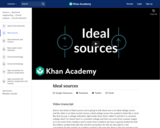
Introduction to the voltage source and current source. Created by Willy McAllister.
- Subject:
- Applied Science
- Engineering
- Material Type:
- Lesson
- Provider:
- Khan Academy
- Provider Set:
- Khan Academy
- Author:
- Willy McMaster
- Date Added:
- 06/03/2016

Introduction to the voltage source and current source. Created by Willy McAllister.
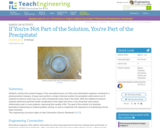
Students continue the research begun in the associated lesson as if they were biomedical engineers working for a pharmaceutical company. Groups each perform a simple chemical reaction (to precipitate solid calcium out of solution) to observe what may occur when Osteopontin levels drop in the body. With this additional research, students determine potential health complications that might arise from a new drug that could reduce inflammatory pain in many patients, improving their quality of life. The goal of this activity is to illustrate biomedical engineering as medical problem solving, as well as emphasize the importance of maintaining normal body chemistry.
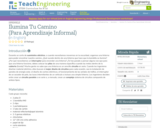
Los estudiantes construyen linternas al tiempo que aprenden sobre circuitos.
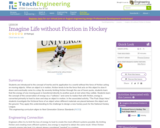
Students are introduced to the concept of inertia and its application to a world without the force of friction acting on moving objects. When an object is in motion, friction tends to be the force that acts on this object to slow it down and eventually come to a stop. By severely limiting friction through the use of the hover pucks, students learn that the energy of one moving puck is transferred directly to another puck at rest when they collide. Students learn the concept of the conservation of energy via a "collision," and will realize that with friction, energy is converted primarily to heat to slow and stop an object in motion. In the associated activity, "The Puck Stops Here," students will investigate the frictional force of an object when different materials are placed between the object and the ground. This understanding will be used to design a new hockey puck for the National Hockey League.
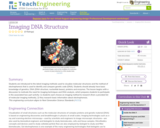
Students are introduced to the latest imaging methods used to visualize molecular structures and the method of electrophoresis that is used to identify and compare genetic code (DNA). Students should already have basic knowledge of genetics, DNA (DNA structure, nucleotide bases), proteins and enzymes. The lesson begins with a discussion to motivate the need for imaging techniques and DNA analysis, which prepares students to participate in the associated two-part activity: 1) students each choose an imaging method to research (from a provided list of molecular imaging methods), 2) they research basic information about electrophoresis.

This video segment adapted from A Science Odyssey looks at the invention of the automobile and the development of mass production.

This video segment adapted from A Science Odyssey looks at the invention of nylon.

This video segment adapted from A Science Odyssey considers modern technology's impact on society.
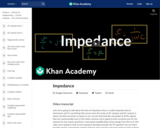
The ratio of a sinusoidal voltage to a sinusoidal current is called "impedance". This is a generalization of Ohm's Law for resistors. We derive the impedance of a resistor, inductor, and capacitor. The inductor and capacitor impedance includes a term for frequency, so the impedance of these components depends on frequency. Created by Willy McAllister.
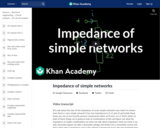
Impedance of 2 elements in series is a complex number. Impedance terminology: reactance, susceptance, admittance. Created by Willy McAllister.
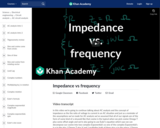
The impedance of capacitors and inductors in a circuit depend on the frequency of the electric signal. The impedance of an inductor is directly proportional to frequency, while the impedance of a capacitor is inversely proportional to frequency. Created by Willy McAllister.
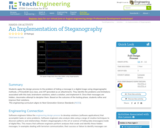
Students apply the design process to the problem of hiding a message in a digital image using steganographic methods, a PictureEdit Java class, and API (provided as an attachment). They identify the problems and limitations associated with this task, brainstorm solutions, select a solution, and implement it. Once their messages are hidden, classmates attempt to decipher them. Based on the outcome of the testing phase, students refine and improve their solutions.

Students are presented with an engineering challenge: To design a sustainable guest village within the Saguaro National Park in Arizona. Through four lessons and six associated activities, they study ecological relationships with an emphasis on the Sonoran Desert. They examine species adaptations. They come to appreciate the complexity and balance that supports the exchange of energy and matter within food webs. Then students apply what they have learned about these natural relationships to the study of biomimicry and sustainable design. They study the flight patterns of birds and relate their functional design to aeronautical engineering. A computer simulation model is also incorporated into this unit and students use this program to examine perturbations within a simple ecosystem. The solution rests within the lessons and applications of this unit.
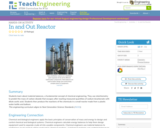
Students learn about material balances, a fundamental concept of chemical engineering. They use stoichiometry to predict the mass of carbon dioxide that escapes after reacting measured quantities of sodium bicarbonate with dilute acetic acid. Students then produce the reactions of the chemicals in a small reactor made from a plastic water bottle and balloon.
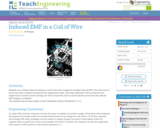
Students use a simple set up consisting of a coil of wire and a magnet to visualize induced EMF. First, students move a coil of wire near a magnet and observe the voltage that results. They then experiment with moving the wire, magnet, and a second, current carrying coil. Students connect the coil to a circuit and the current from the induced EMF charges a conductor.
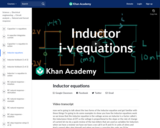
We look at the inductor i-v equations in derivative and integral form. Created by Willy McAllister.

We notice how important it is to give inductor current a place to flow. Created by Willy McAllister.
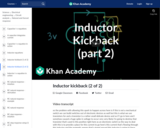
We give the inductor's kickback current a path to flow by adding a diode. Created by Willy McAllister.
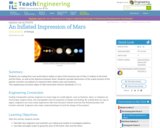
Students use scaling from real-world data to obtain an idea of the immense size of Mars in relation to the Earth and the Moon, as well as the distances between them. Students calculate dimensions of the scaled versions of the planets, and then use balloons to represent their relative sizes and locations.
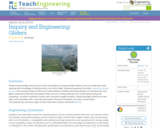
Student teams design, build and test small-sized gliders to maximize flight distance and an aerodynamic ratio, applying their knowledge of fluid dynamics to its role in flight. Students experience the entire engineering design process, from brainstorming to CAD (or by hand) drafting, including researching (physics of aerodynamics and glider components that take advantage of that science), creating materials lists, constructing, testing and evaluating—all within constraints (works with a launcher, budget limitation, maximizing flight distance to mass ratio), and concluding with a summary final report. Numerous handouts and rubrics are provided.